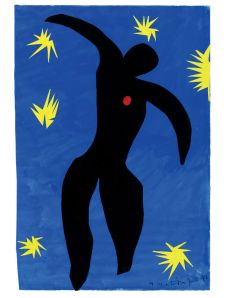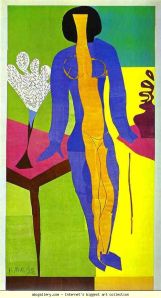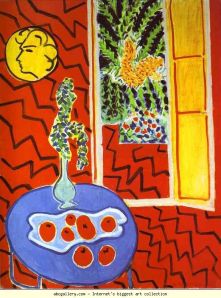Back at Tate Modern this weekend for the second look at the Matisse Cut-Outs and yes, they’re glorious, especially when viewed in the sparsely populated first hour allocated to members; glorious in their exultation of colour and rhythm, their understanding of form and space, and yet … yet why do I come away each time harbouring some small but irrepressible feeling of dissatisfaction?
T. J. Clark, in his piece about the show in the June 5th issue of the London Review of Books, points, perhaps, towards the answer when he quotes a letter from Matisse to his daughter, Margueritte, written to her in 1945 when she was recovering from her time in a Gestapo prison in Rennes.
Paintings seem to be finished for me now … I’m for decoration – there I give everything I can – I put into it all the acquisitions of my life. In pictures I can only go back over the same ground.
And going over the same ground, as Matisse explained in a letter to his son, meant pain …
A man who makes pictures … is an unhappy creature, tormented day and night. He relieves himself of his passion in his pictures, but also in spite of himself on the people round him. That is what normal people never understand.
And, after the war, older, infirm, why put yourself through that again? Why not use those skills which, as he says, he has accumulated over a lifetime and put them to lighter, less threatening, more obviously pleasing use? So decorate the walls of your house and studio; the walls and windows and clerical garments of your local church; accept the commission from some rich American to provide artistic decoration for his house and when he rejects it as unsuitable – perhaps the colour ways clashed with the cushions, who knows? – as he does not once but twice, bite your tongue and do it again until finally he’s satisfied. What does it matter, after all? It’s work like much other … not highly personal … not art but decoration …
As Clark says, “only a killjoy … could resist the splendour on the walls,” but with a few exceptions … Zulma, Creole Dancer, Memory of Oceania …there is little that take us beyond our initial pleasure – brilliant, yes, and joyous – and each time we see them it will be the same.
Is this something to do with the material used? Paper or card instead of paint? What are the cut-outs, after all, but coloured shapes pretending to be paint because the artist can’t – physically, emotionally – paint any more.
I was thinking of the recent show of paintings by Helen Frankenthaler at Turner Contemporary, where the viewer’s initial response is to colour and form, and the recognition here and there of aspects of landscape and the natural world, but always, I think, beyond that something more, out of reach of our understanding, something that no matter how hard, how often we look, refuses to be pinned down in the way that Matisse’s cut-outs are pinned down.
Paint on canvas doing what paint does, is that all it is?
Amongst the other work on display, there are two paintings … Interior with Black Fern from 1948 and Red Interior: Still Life on a Blue Table, 1947 … which suggest that might be so. That and the willingness to engage … but after so much challenging work, so long a life, who can blame him for relinquishing the pain while still using those skills he has learned to such formidable effect as this?


